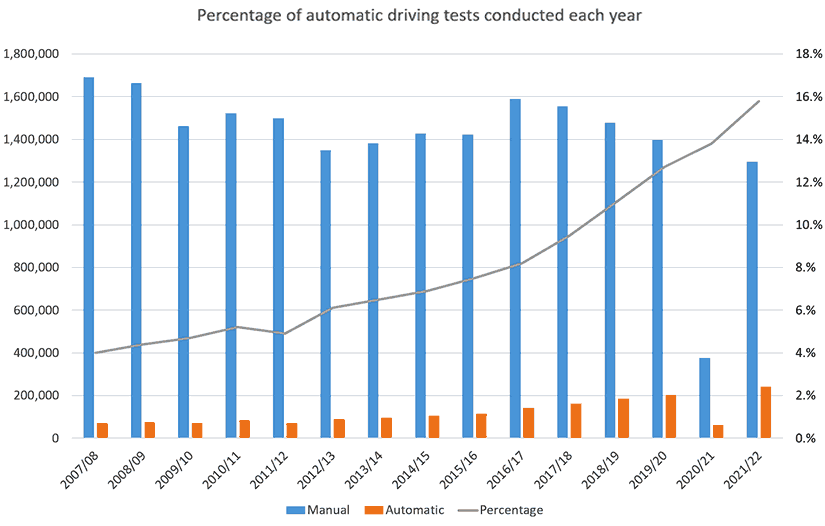With every passing year, a higher percentage of driving test candidates are deciding to take the driving test in an automatic car. Let’s take a look at the official DVSA driving test statistics.
Annual Percentage of Automatic Driving Tests Conducted
From the statistics table, annual figures are captured from the month of April, through to March the following year. In that time frame is the total amount of manual tests conducted, followed by the total amount of automatic tests conducted and finally, the percentage of automatic tests taken.
| Year | Manual | Automatic | Percentage |
|---|---|---|---|
| 2007/08 | 1,691,934 | 70,429 | 4.0% |
| 2008/09 | 1,663,541 | 75,716 | 4.4% |
| 2009/10 | 1,462,585 | 71,454 | 4.7% |
| 2010/11 | 1,522,045 | 83,554 | 5.2% |
| 2011/12 | 1,498,640 | 70,429 | 4.9% |
| 2012/13 | 1,348,637 | 87,844 | 6.1% |
| 2013/14 | 1,381,826 | 95,759 | 6.5% |
| 2014/15 | 1,426,556 | 105,948 | 6.9% |
| 2015/16 | 1,422,741 | 114,994 | 7.5% |
| 2016/17 | 1,589,672 | 141,264 | 8.2% |
| 2017/18 | 1,554,729 | 163,790 | 9.5% |
| 2018/19 | 1,479,176 | 185,043 | 11.1% |
| 2019/20 | 1,397,060 | 202,506 | 12.7% |
| 2020/21 | 375,835 | 60,209 | 13.8% |
| 2021/22 | 1,295,601 | 242,713 | 15.8% |
Here we can see the increases in percentage of those taking the automatic test compared to manual. With every passing year, more candidates are choosing automatic, but why is this?
Decline in the Manual Car
The UK, along with the rest of Europe has long favoured the traditional stick shift. In the UK, a decade ago, 80 percent of all new car sales were those with a manual transmission. As of 2022, automatics have for the first time eclipsed sales of manuals with 54 percent of new car buyers opting for automatic transmission.
Many learner drivers have a combination of professional lessons with a driving instructor and private tuition from parents. If the parents are driving an automatic, it’s going to influence their decision on choosing to learn in a manual or automatic.
Automatics are Easier to Drive
There’s really no way around it, on todays roads, automatics are far easier to drive. Britain currently has the third most congested roads in Europe, with the average driver spending 32 hours per year stuck in traffic queues. With that level of moving off and stopping, the constant operating of the clutch and gear shifts becomes tedious and tiring.
Many individuals who are starting out learning to drive are going to be thinking why spend all this time and effort pointlessly operating the clutch and gear lever when you can have a car that does it automatically?
Automatic are Easier for Learning to Drive
Mastering clutch control with a perfectly timed gear change takes a good amount of time out of your driving lessons. You can do away will all that along with the frustrating stalling by simply learning in an automatic. It’s not only easier to learn to drive in an automatic car, but by doing so, you will often reduce the amount of hours required to reach test standard.
Government Regulation
In a bid to reduce CO2 emissions, we then of course have the ban on conventional petrol and diesel cars and vans from 2030. This has of course resulted in a surge of battery electric cars, all of which are automatic. Hybrid cars and vans that can go a considerable distance on zero emissions technology can continue to be sold up until 2035. As with electric only cars, most hybrids are also automatic transmission.
As 2030 draws closer, the influence on electric and hybrid cars and their automatic transmissions will only serve to increase the percentage of those taking the automatic driving test.
